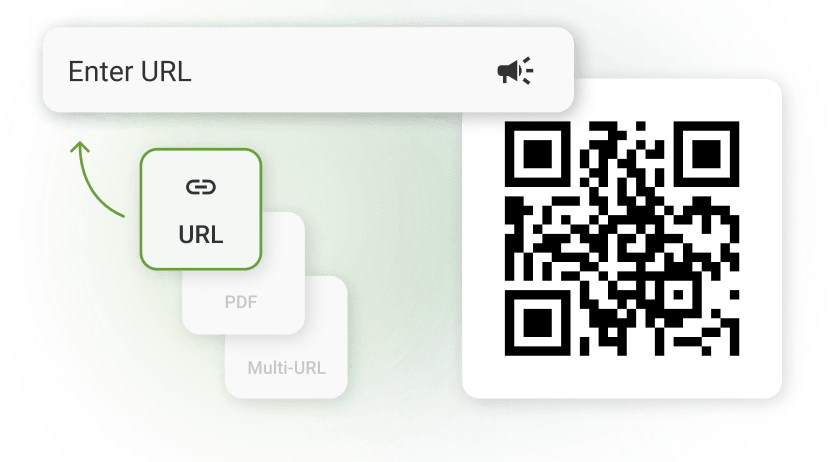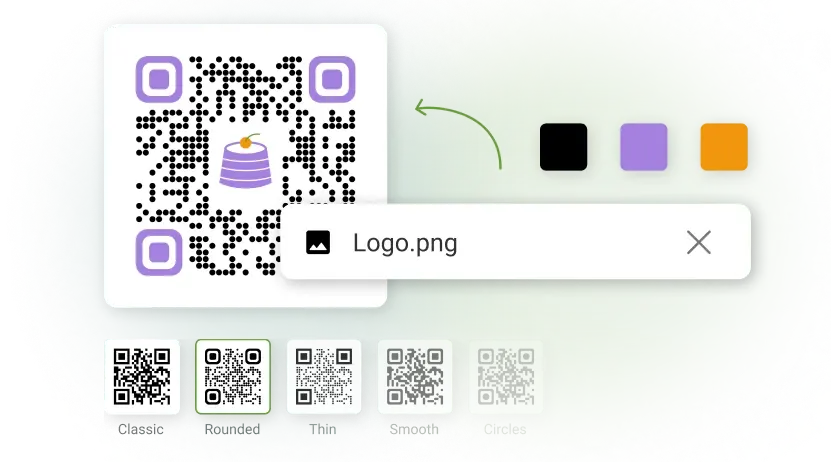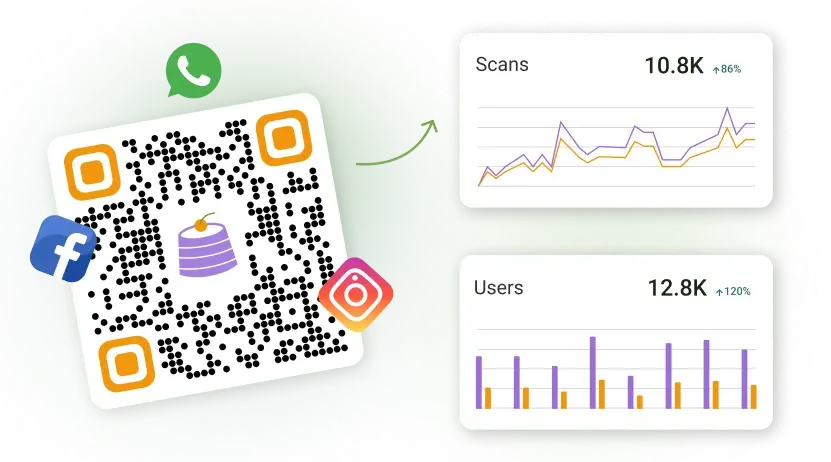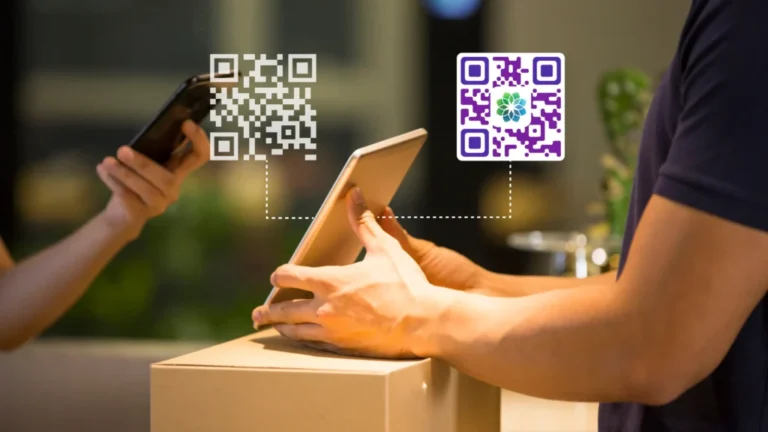Static QR Codes and dynamic QR Codes: these are two terms you may have heard often in the world of QR Codes. It may have struck you: what is the difference between them?
The main difference between a dynamic QR code and a static QR code is twofold: editability and tracking. Static QR codes store fixed information that can’t be changed once generated, and they offer no way to monitor performance. Dynamic QR codes, on the other hand, let you update the destination anytime—and track scans in real time.
This flexibility and insight make dynamic QR codes a smarter choice for businesses that want to stay agile and data-driven. Whether you’re promoting limited-time offers, updating content on the fly, or analyzing scan performance, dynamic QR codes give you the control static ones simply can’t.
In this post, we compare static vs. dynamic QR Codes in terms of their differences, pros and cons, and use cases. Finally, we will help you decide which is right for your business.
Static vs. dynamic QR Code: What is the difference?

A static QR Code is fixed whereas a dynamic QR Code is flexible. This means once you create a static QR Code, you can’t change it. However, you can change the content and URL of dynamic QR Codes.
This is the most fundamental difference between dynamic and static QR Codes.
There are some other factors too that separate dynamic QR Codes from static ones. For example, you can track dynamic QR Codes, but not static ones.
Here are the detailed differences between dynamic and static QR Codes:
| Parameters | Dynamic QR Codes | Static QR Codes |
| Can you edit the content or URL? | Editable: You can change the content and the URL without changing the QR Code. | Not editable: The QR Codes you create are fixed and can’t be edited. |
| Can you track your QR Codes? | Trackable: You can track the QR Codes and get multiple data points, including scan counts, locations, and device types. | Not trackable: You can’t track the QR Codes or get scan analytics. |
| How cost-effective are they? | Cost-effective: You can update the same QR Code without creating another one or printing from scratch. This saves manual efforts and printing costs. | Not cost effective: Any change needs you to create and print new QR Codes. This increases time, effort, and printing costs. |
| How is the scan experience for customers? | Better user experience: Prospects will always see the latest information, enhancing their experience. | Standard user experience: Prospects will see a fixed information, unless informed about the changes and presented with a new QR Code. |
| What are the various use cases? | Diverse use cases: You can use them for campaigns that are bigger and more complex, need personalization, and require tracking analytics. | Limited use cases: You can use them for smaller or one-time campaigns, that don’t require much editing or tracking. |
Static QR Code: Meaning, pros & cons, use cases
What is a static QR Code?
A static QR Code is a type of QR code where the actual destination data (like a website URL, a piece of text, an email address, or contact information) is directly encoded into the QR code’s pattern. Once generated, this information is permanent and cannot be altered without creating an entirely new QR code.
Static QR codes work by having the data literally embedded within their black and white modules. When a smartphone or scanner reads the pattern, it decodes this directly embedded information and presents it to the user or performs the encoded action (e.g., opening a URL). There is no intermediary server or redirect involved for the primary data retrieval.
What are the pros and cons of static QR Codes?
✅ Pros:
- Easy to create: They are quick and easy to create, with a simple, online QR Code generator
- Direct access: Prospects can access the encoded information directly without requiring a server as a medium
- Works Offline (for certain data types): If a static QR code contains simple text, a phone number, or SMS information, that data can be read and utilized by the scanning device even without an active internet connection. (URLs, of course, still require internet to open).
- Permanence (for unchanging data): Suitable for information that is guaranteed not to change, such as a reference number or a link to a historical document.
Create a lifetime free static QR Code — No signup required!
❌ Cons:
- Non-Editable: This is the biggest drawback. If the linked website URL changes, if there’s a typo, or if the information becomes outdated, the static QR code becomes useless, and you must generate and distribute a new one. This can be costly and inefficient if codes are already printed on materials.
- Not Trackable: It’s generally impossible to gather scan analytics (number of scans, location, device type) from static QR codes. This means you have no insight into how effectively they are being used.
- Limited Data & Denser Codes: Longer URLs or more data directly encoded into a static QR code result in a denser, more complex pattern. This can potentially make the QR code slightly harder to scan, especially if printed small or viewed from a distance, and may affect scan speed.
- Less Professional for Dynamic Needs: For business or marketing, relying on static codes for information that might evolve can appear unprofessional if users encounter dead links or outdated content.
- Limited Customization: While basic color changes might be possible, features like embedding a logo robustly are typically better supported by dynamic QR code systems which can manage the error correction needed.
What are the common use cases of static QR Codes?
- Permanent information: Storing fixed data, such as contact details, website URLs, or event data.
- One-time campaigns: For promotional materials or events where the content doesn’t need to be updated.
- Personal use: Sharing information with friends or family without tracking or analytics.
- Solopreneur uses: Sharing easy access to fixed assets, such as social media accounts, brochures, portfolios, or case studies.
What are some popular examples of static QR Code campaigns?
Business cards
Static QR Codes on business cards can directly share contact information, such as phone numbers, email addresses, and LinkedIn profiles. Once scanned, they automatically save the contact details to the user’s phone, providing a quick and convenient way to connect.

Product labels
Static QR Codes are often used on product packaging to provide essential information such as ingredients, usage instructions, or safety warnings. Since the information on the label does not change frequently, static QR Codes offer a reliable and cost-effective solution.

Educational materials
In educational settings, static QR Codes can link to study materials, such as textbooks, reference guides, or online resources. They provide a simple way for students to view additional information or resources without the need for frequent updates.

Dynamic QR Code: Meaning, pros & cons, use cases
What is a dynamic QR Code?
A dynamic QR Code is a more advanced and flexible type of QR code where the destination content or URL can be edited at any time, even after the QR code has been generated and distributed. This is because the QR code itself doesn’t directly contain the final destination data.
Instead, a dynamic QR code encodes a short, unique redirect URL (managed by the QR code generator platform). When this QR code is scanned, the device is first directed to this short URL. The server then looks up the current destination associated with that short URL and redirects the user to it. This intermediary step is what allows the final destination to be changed without altering the printed QR code, and it’s also how scan tracking is enabled.
What are the pros and cons of dynamic QR Codes?
✅ Pros:
- Editable content & URL: The most significant advantage. Update links, correct typos, or change entire campaigns linked to the QR code without reprinting or redistributing it. This saves time, money, and effort, especially for printed materials.
- Scan tracking & analytics: Provides valuable insights into user engagement, including the number of scans, scan locations, dates/times of scans, and device types used. This data is essential for measuring ROI and optimizing marketing efforts.
- Cleaner, more scannable codes: Because they encode a short URL, dynamic QR codes generally have less dense patterns than static codes with long URLs. This can improve scan speed and reliability, especially at smaller sizes or longer distances.
- Advanced features:
- Device-Based redirection (Multi-URL): Send users to different URLs based on their device OS (e.g., iOS users to App Store, Android users to Play Store).
- Geo-targeting: Redirect users to different content based on their geographical location.
- Scan limits & expiration dates: Set a QR code to deactivate after a certain number of scans or on a specific date.
- Retargeting capabilities: Integrate with platforms like Facebook Pixel or Google Analytics to retarget users who have scanned your QR code.
- A/B testing: Test different landing pages by changing the destination URL to see which performs better.
- Enhanced customization & branding: Dynamic QR code platforms often offer more robust options for adding logos, custom colors, and frames, while ensuring scanability is maintained through managed error correction.
- Professional appearance: Using dynamic codes shows a commitment to providing up-to-date information and a more sophisticated approach to digital engagement.
❌ Cons:
- Requires account/subscription (in most cases): Creating and managing dynamic QR Codes—especially with advanced features and tracking—usually requires signing up for a paid account with a QR Code platform. Most services don’t offer dynamic QR Codes for free, but a few do. Click here to create a fully free dynamic code.
- Dependency on the QR Code provider’s server: Since dynamic QR codes rely on a redirect URL managed by the generator’s platform, their continued functionality depends on that service remaining active and the short URL being maintained. Choosing a reputable provider is key.
- Internet connection required for redirection: The scanning device needs an internet connection to resolve the short URL and be redirected to the final destination.
What are the common use cases of dynamic QR Codes?
- Flexible information: Using QR Code for use cases where links are prone to change, such as landing pages, mobile apps, and website URLs.
- Long-term campaigns: For large-scale and long-running campaigns that need to be optimized regularly.
- Professional use: Using QR Codes to get more traffic, customers, or better customer service.
- Startup uses: Creating QR Codes for variable assets, such as social media channels, products, property listings, or promotional materials.
What are some popular use cases of dynamic QR Codes?
Marketing campaigns
Businesses use dynamic QR Codes in marketing materials, enabling them to direct users to landing pages, promotional offers, or social media profiles that can be updated as needed without reprinting materials.

Event management
Dynamic QR Codes are often used to handle event registrations, provide up-to-date event schedules, or share location details. The ability to update information ensures attendees always have the latest details.

Product tracking
Dynamic QR Codes are used in logistics and inventory management, allowing companies to update product information, track shipments, or provide warranty details that can be accessed by scanning the code.

Why dynamic QR Codes offer a significant advantage over static QR Codes
The previous sections have detailed the individual characteristics, but when you directly compare them for most business and marketing purposes, dynamic QR codes emerge as the clear winner. The shift towards dynamic isn’t just a preference; it’s a strategic business decision.
- Future-proof your efforts with editability: The single biggest pain point of static QR codes is their permanence. A typo, a changed URL, or an outdated promotion renders a printed static QR code obsolete, often leading to wasted marketing spend and frustrated users. Dynamic QR codes eliminate this entirely. You can update the destination URL or content behind the same printed QR code infinitely, ensuring your campaigns remain relevant and effective.
- Gain invaluable insights with tracking & analytics: In a data-driven world, understanding user engagement is paramount. Static QR codes offer zero visibility into their performance. Dynamic QR codes, however, provide a wealth of analytics – how many people scanned your code, when, where (geographically), and often with what type of device. This data is gold for measuring ROI, understanding customer behavior, and refining your marketing strategies.
- Enhance user experience (UX): By ensuring that a QR code always leads to live, relevant, and up-to-date information, dynamic QR codes provide a superior user experience. Users aren’t met with “404 Not Found” errors or outdated offers, which protects your brand credibility. The generally simpler patterns of dynamic QR codes (due to short redirect URLs) can also contribute to faster, more reliable scanning, especially in less-than-ideal conditions or at smaller print sizes.
- Unlock advanced marketing capabilities: Dynamic QR codes are the gateway to sophisticated marketing tactics. Features like:
- Retargeting: By linking to a webpage with a tracking pixel, you can retarget users who scanned your QR code with online ads on platforms like Facebook or Google.
- A/B testing: Test different landing pages or offers by changing the dynamic QR code’s destination to see which converts better.
- Device-specific content: Deliver tailored experiences by redirecting users to different URLs based on their device operating system (e.g., iOS vs. Android).
- Time-sensitive offers: Set QR codes to redirect to different content at different times or to expire after a promotion ends. These capabilities are simply unavailable with static codes.
- Professionalism and brand control: Utilizing dynamic QR codes signals that your business is digitally savvy and committed to providing accurate information. The ability to manage and update your links centrally gives you greater control over your brand’s digital touchpoints originating from print or physical locations.
While static QR codes have their place for very simple, unchanging data, the moment your information is likely to evolve, you need to track engagement, or you want to leverage advanced marketing features, dynamic QR codes become the indispensable choice.
Choosing the right QR Code: Static or dynamic? (expanded guide)
The decision between a static or dynamic QR code hinges entirely on your specific use case, your need for flexibility, your desire for analytics, and your long-term content strategy.
Opt for a static QR Code if:
- The information is truly permanent: The linked data (e.g., a foundational website URL that will never change, your fixed email address, a piece of unchanging text like a serial number) is absolutely stable and will not require updates.
- No tracking is needed: You have no requirement to know how many people are scanning the code, where they are, or when.
- It’s a one-time, low-stakes use: For a quick, informal share where longevity and tracking are irrelevant (e.g., sharing a Wi-Fi password with a guest for a day).
- Offline access to simple data is key: If the code contains simple text, a phone number, or SMS details, and it needs to be readable even without an internet connection on the scanning device.
- Budget is extremely constrained & needs are basic: You need the quickest, simplest, often free generation method for a very basic link and cannot accommodate even a minimal subscription for dynamic features.
You should strongly choose a dynamic QR Code if:
- Information might change or evolve: This is the primary driver. If there’s any chance the linked URL, content, promotion, or details might need updating, a dynamic QR code will save you from costly reprints and ensure continued functionality. This applies to marketing materials, product information that gets updated, event details, restaurant menus, business contact information, etc.
- Tracking scans and measuring ROI is important: For any marketing campaign or business application, understanding user engagement through scan analytics (how many, when, where) is crucial to gauge effectiveness and optimize future efforts.
- You want to use advanced features: If you plan to leverage capabilities like password protection, A/B testing landing pages, retargeting users, setting expiration dates, or redirecting users based on their device or location, dynamic QR codes are essential.
- Maintaining a professional image is key: Ensuring links are never broken and information is always current reflects well on your brand. Dynamic codes help achieve this.
- Scan speed and reliability with complex URLs are concerns: Dynamic QR codes use short redirect URLs, resulting in simpler QR code patterns that can be scanned more reliably and quickly, especially when the final destination URL is long or complex.
- You’re running marketing campaigns: Virtually all marketing use cases benefit immensely from the editability and trackability of dynamic QR codes.
- Scalability is a factor: As your campaigns or information needs grow, dynamic QR codes offer the flexibility to manage and update content efficiently without having to replace every physical instance of the code.
Ultimately, your choice will depend on your content management, tracking, and budget requirements. If your priorities are simplicity and cost, a static QR Code generator will be enough. For priorities such as flexibility, tracking, and more personalization, a dynamic QR Code generator will likely serve you better.
The QR Code Generator offers both static and dynamic QR Codes, allowing you to choose based on your specific needs.
Frequently asked questions
1. How to create dynamic QR Codes for free?
You can create a dynamic QR Code for free in four simple steps:
- Sign up for a free dynamic QR Code generator (for example, The QR Code Generator) and select ‘Dynamic QR Code’
- Choose the QR Code type (URL, PDF, app, etc.)
- Customize your QR Code as per your preference (for example, add a logo)
- Download your free dynamic QR Code and start using it
2. What types of static and dynamic QR Codes can I create?
The QR Code Generator offers nine QR Code types to meet diverse needs: URL, PDF, Multi-URL, Contact, Plain Text, App, SMS, Email, and Phone. Among these, PDF, Multi-URL, and App QR Code types are available only as dynamic QR Codes. The remaining QR Code types can be either static or dynamic. For instance, a URL QR Code can be either a static QR Code or a dynamic QR Code, depending on your requirements.
3. What is a custom QR Code, and is it dynamic or static in nature?
A custom QR Code is a personalized QR Code designed with unique elements such as colors, logos, and branding to match a specific look or theme. Custom QR Codes can be either dynamic or static.
On The QR Code Generator, you can create both static and dynamic custom QR Codes for free. However, adding a logo is only possible with dynamic QR Codes.
4. Do I need a dynamic QR Code?
This depends completely on your use case. If you need to create larger campaigns and need more control over them (like make them branded or track them), you’ll need to choose a dynamic QR Code.
5. Can I convert a static QR Code to a dynamic QR Code?
You can’t change a static QR Code into a dynamic QR Code. This is because the data is already encoded in a static QR Code, making it permanent. However, you can create a dynamic QR Code from scratch and edit it, if required
6. Are the QR Codes generated by Google Chrome static or dynamic?
You can create a QR Code for any page by right-clicking and choosing ‘Create a QR Code for this page’. However, this feature by Google only lets you create a static QR Code, that too with Google’s dinosaur logo.
7. How can businesses benefit from static and dynamic QR Codes?
Static and dynamic QR Codes both have their unique use cases. While static QR Codes can be used for business cards and product packaging, dynamic QR Codes can be used for marketing campaigns and inventory management.








